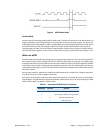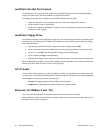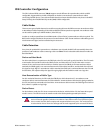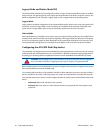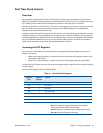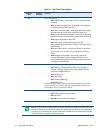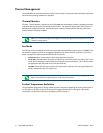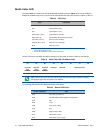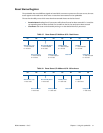BDM-610000049 Rev G Chapter 4: Using the cpuModule 73
Power Management
The CMX158886 cpuModule supports various powering mechanisms which allow the cpuModule to monitor
power consumption and temperature, and achieve minimal power consumption states. These unique features
include Enhanced Intel® SpeedStep® Technology (PX only), thermal monitoring and thermal throttling, as well as
low power modes including ACPI configurations. Various wake options are also available to resume normal
system power.
Enabling Enhanced Intel SpeedStep Technology (PX only)
When enabled, Enhanced Intel® SpeedStep® Technology can give application software greater control over the
processor’s operating frequency and input voltage. This allows the system to easily manage power consumption
dynamically. This feature can be enabled or disabled in the BIOS. When enabled, the feature can be set to several
different modes, which are described below.
• Maximum Speed: The processor speed is set to its maximum operating frequency.
• Minimum Speed: The processor speed is set to its minimum operating frequency.
• Automatic: When set to automatic mode, the processor speed is controlled by the operating system.
Advanced Configuration and Power Interface (ACPI)
The cpuModule supports several different ACPI low power modes, including the S1, S3, S4, and S5 sleeping states.
The BIOS setup utility provides an option to select between S1 and S3 as the Standby state. Sleep modes S4 and
S5 are setup by the operating system.
The cpuModule’s ACPI suspend modes are described below
• S1 (Power on Suspend): The S1 low power state consumes the most power of all supported ACPI sleep
modes. In this mode, the CPU stops executing instructions, but power to the CPU and RAM is
maintained.
• S3 (Suspend to RAM): Everything in the system is powered off except for the system memory. When
the system wakes from this mode, operating systems allow applications to resume where they left off,
as the state of the application is preserved in memory.
• S4 (Hibernate): When the system enters this state, the operating system will save the current state of
applications and relevant data to disk, thus allowing the system RAM to be powered down.
• S5 (Soft-Off): The system is in a soft off state, and must be rebooted when it wakes.
Power Button Modes
The soft power button input of the utility port connector (CN5) can be configured by the operating system as
a suspend button (transition to S1 or S3) or as soft power button (transition to S5). Consult your operating
system documentation for information on how to configure it. The power button will always cause a transition
to S5 if pressed for 4 seconds or longer, without interaction from the operating system.
Low-Power Wake Options
The cpuModule supports several methods of waking from a low power state. Several of these wake options are
BIOS configurable, and can be accessed directly from the “Power” menu in the BIOS setup:
• Resume on Ring: While in a low power mode, the ring indicator input of either COM port may be used
to wake the system.



